Mirror Work
Sep 21, 2019 • 438 views
History
Mirror work embroidery also known as shisheh or abhla bharat embroidery has its origin rooted in the 17th century. Started in Iran and brought to India from the Muslim lands under the Mughal empire, mirror work gradually spread to different parts of the Indian subcontinent such as Gujarat, Rajasthan, Haryana, Delhi, Andhra Pradesh, Punjab region etc. Despite the fact that this embroidery work got popular during the Mughal era, the rulers of the same weren't seen wearing clothes or accessories having this kind of embroidery but it is their decor that showcased this art of embellishment. This kind of embroidery though belonging to some other part of the world, easily fused itself into the life of the people of the country. It soon was adopted by a number of indigenous tribes and can be seen in the kind of traditional outfits that they wear.

Mirror Work on Fabrics- Source : Oh My Rajasthan
How to Do it
Originally, Mica is the substance which was used to do mirror embroidery which was then replaced by elements like beetle, tin, silver and coins. By the 20th century, however, large thin bubbles which were then broken into small pieces of glass replaced all the previously used elements. These mirrors having a convex curve are the ones which are used in the current times as well. The mirrors used in this embroidery come in various shapes and sizes such as circular, triangular, rectangular, etc. Despite the fact that there are numerous ways to embroider using mirrors, I would describe two of the easiest methods which are as follows -
ATTACHING A MIRROR USING A FRAME
The first thing that needs to be done in any kind of mirror embroidery, is to stick the mirror on the fabric.
The next step in this method is to make a frame using embroidery thread.
Firstly the embroidery thread is to be coiled 3-4 times either around our finger or according to the size of the mirror.
Now gently remove the coil from the fingers.
Next put a six strand embroidery thread into the needle and start rounding the needle from inside of the coil to outside, then inside again and keep on repeating this so as to form a blanket.
After completing one round of blanket stitch, add 3-4 more layers so as to widen the frame.
The next and the final step is to attach the frame onto the mirror using small stitches.
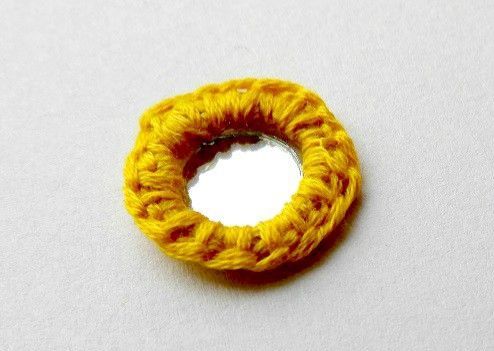
Mirror Attached Using a Frame - Source: Sew Guide
GLUE AND BEAD METHOD
The first step is to stick the mirror on the fabric
Next step is to attach the beads. Now this could be done in two ways.
First way would be to simply stick the beads very closely round the mirror.
Another alternative way would be to put all the beads in a string and then glue them around the mirror.
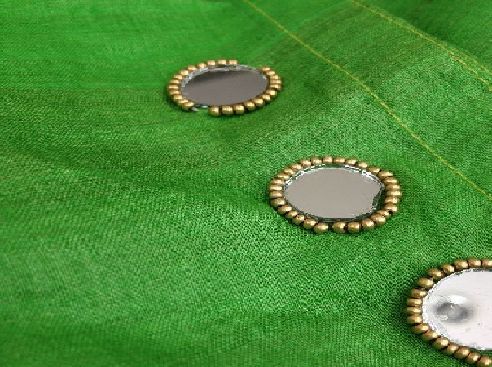
Mirror Attached Using Beads - Source: Sew Guide
It is important to remember that though glue and beads method is very easy, it is suitable only for clothes that are not going to be washed frequently and never in a washing machine.
Sources of Inspiration
The start of usage of mirrors in the embroidery work was essentially inspired by the women from South Asia. They used a very special technique of making circular mirrors. They used to use specially designed scissors dampened to prevent the shards from flying and then cut them into small circular shapes. It is this art of intricately making the mirrors that inspired some people to use them as a part of their embroidery.
Religious Significance
There are some religious beliefs attached to the usage of mirrors in the craft followed by a number of communities in different parts of the country. In some states, Gujarat, Madhya Pradesh, Rajasthan and Haryana to be specific, people belonging to the religion of Hinduism, Jainism and Islam believe that tying a abla bharat torana or a shisha torana to the front door of their houses can help in warding off the evil spirits.
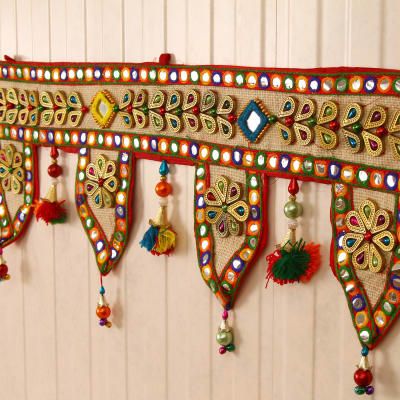
Mirror Work Toran - Source : IGP
Influence Over the Years
The major hubs of Shisha embroidery or mirror work are seen in the states of Rajasthan, Gujarat and Haryana. But within these states, the embroidery work has been influenced and used in different ways by different communities. For example, mirrors of various shapes and sizes are used by the Jats of Banni to decorate their fabrics whereas the community of Garari Jats use tiny mirrors that are embellished on the yoke of the dress with colorful threads. There are various others ways in which mirrors are used as a part of the embroidery and this change can be seen with changing regions and communities.
Mirror Work in the Contemporary Times
Like any other art form, Mirror work or Shisha embroidery too has evolved with the changing times. Gone are the days where mirrors were used only to embellish traditional clothing materials. In the current scenario this embroidery technique has broadened its horizons and has moved onto various other products. Whether it is in home decor elements or in craft work, mirror work has made its space everywhere. It is used in objects such as curtains, cushions, bedspreads, wall hangings etc. Even in the clothing and accessory industry this kind of embroidery is being experimented so as to fuse it with clothes other than the traditional ones and in other objects.
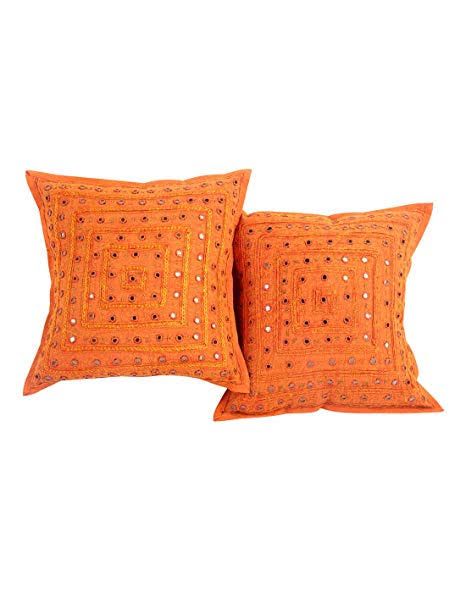
Mirror Work Cushions- Source : Amazon
Nowadays jeans, skirts, shirts and even neckpieces bear this kind of work. All in all, it will not be wrong to say that the present is seeing the magic of this embroidery and the future will too.
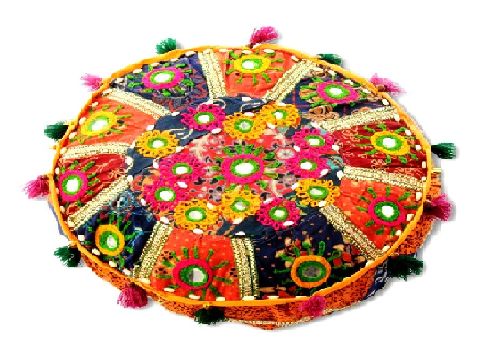
Mirror Work Case - Source : Utsavpedia
Interesting Facts
Mirror work embroidery was secretly admired by one of the merchant travellers from Italy, Marco Polo.
The outfits worn by Deepika Padukone in the movie Ram Leela very graciously flaunt the mirror work embroidery of Rajasthan.
Mirror work is also seen as a therapeutic exercise to lessen anxiety and boost self-confidence.
